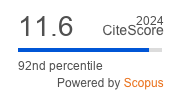MOBILE SINK PATH FORMATION TO EXTEND THE NETWORK LIFETIME IN WSN
DOI:
https://doi.org/10.29284/ijasis.8.2.2022.26-35Keywords:
Cluster head, wireless sensor networks, mobile sink route, network load, energy efficiency.Abstract
Wireless Sensor Network (WSN) is a group of sensor nodes that is utilized to observe and record the several physical, environmental, and significant real time data.Data traffic obtained through the Base Station (BS) in WSN minimizes the energy of close sensor nodes as equated to other sensor nodes. This issue is called as hot spot issue in the WSN. But, the Mobile Sink (MS) is proposed for solving this hot spot issue in the WSN. MS is used to gather the modified information from the Cluster Head (CH) and it forward to the BS. This approach presents a Mobile Sink Path Estimation (MSPE) to extend the network lifetime in WSN. The major objective of this article is to designing a MS route to minimizing the energy utilization and delay. In this approach each CH has a threshold level of the load ahead of that if there is an inflow of data, then the node routinely forwards an Mobile Sink Route Request (MS_REQ) for assist from the MS. Depend on the requests received from all CH nodes; the MS evaluates the most appropriate region to move other position. We examine the function of MSPE approach by applying Network simulator. Simulation results demonstrate that the introduced MSPE approach has enhanced the residual energy and minimized the network delay.
References
H .Landaluce, L. Arjona, A. Perallos, F. Falcone, I. Anguloand F. Muralter, “A review of IoT sensing applications and challenges using RFID and wireless sensor networks,”Sensors, vol. 20, no. 9, 2020, pp. 2495-2501.
R. Dhaya, R. Kanthavel and A. Ahilan, “Developing an energy-efficient ubiquitous agriculture mobile sensor network-based threshold built-in MAC routing protocol (TBMP),” Soft Computing, vol. 25, no. 18, 2021, pp. 12333-12342.
T.A. Alghamdi, “Energy efficient protocol in wireless sensor network: optimized cluster head selection model,” Telecommunication Systems, vol. 74, no. 3, 2020, pp. 331-345.
M. Guerroumi, N. Badacheand S. Moussaoui, “Mobile sink and power management for efficient data dissemination in wireless sensor networks,” Telecommunication Systems, vol. 58, no .4, 2015, pp. 279-292.
T.H. Khan and D.S.Kumar, “Ambient crop field monitoring for improving context based agricultural by mobile sink in WSN,” Journal of Ambient Intelligence and Humanized Computing, vol. 11, no. 4, 2020, pp.1431-1439.
M. Mishra, K. Nitesh and P. Jana, “A delay-bound efficient path design algorithm for mobile sink in wireless sensor networks,”3rd international conference on recent advances in information technology, 2016, pp. 72-77..
S. Sahu and S. Silakari, “Distributed Multilevel k-Coverage Energy-Efficient Fault-Tolerant Scheduling for Wireless Sensor Networks,” Wireless Personal Communications, vol. 124, 2022, pp. 2893-2922.
M.R. Majma, S. Almassi and H. Shokrzadeh, “SGDD: self‐managed grid‐based data dissemination protocol for mobile sink in wireless sensor network,” International Journal of Communication Systems, vol. 29, no. 5, 2016, pp. 959-976.
M. Abo-Zahhad, S.M. Ahmed, N. Sabor and S. Sasaki, “Mobile sink-based adaptive immune energy-efficient clustering protocol for improving the lifetime and stability period of wireless sensor networks,” IEEE sensors journal, vol. 15, no. 8, 2015, pp. 4576-4586.
S. K. Gupta and P.K. Jana, “Energy efficient clustering and routing algorithms for wireless sensor networks: GA based approach.” Wireless Personal Communications, vol. 83, no. 3, 2015, pp. 2403-2423.
J. Wang, Y. Gao, C. Zhou, S. Sherratt and L. Wang, “Optimal coverage multi-path scheduling scheme with multiple mobile sinks for WSNs,” Computers, Materials & Continua, vol. 62, no.2, 2020, pp. 695-711.
M. Usman, M.A. Jan, X. Heand J. Chen, “A mobile multimedia data collection scheme for secured wireless multimedia sensor networks,” IEEE Transactions on Network Science and Engineering, vol. 7, no. 1, 2018, pp. 274-284.
S. Sharma, D. Puthal, S.K. Jena, A.Y. Zomayaand R. Ranjan, “Rendezvous based routing protocol for wireless sensor networks with mobile sink,” The journal of Supercomputing, vol. 73,. no. 3, 2017, pp. 1168-1188.
R. M. Zuhairy and M.G. Al Zamil, “Energy-efficient load balancing in wireless sensor network: An application of multinomial regression analysis,” International Journal of Distributed Sensor Networks, vol. 14, no 3, 2018, pp. 1-11.
S. Li, W. Sun and N. Tian, “Resource allocation for multi-class services in multipath networks. Performance Evaluation, vol. 92, 2015, pp. 1-23.
S.G. Rameshkumar, “Improving Quality of Service through enhanced node selection technique in Wireless Sensor Networks,” International Journal of MC Square Scientific Research, vol. 8, no.1, 2016, pp. 141.150.
Downloads
Published
Issue
Section
License
Copyright (c) 2022 Azath Mubarakali & Abdulrahman Saad Alqahtani

This work is licensed under a Creative Commons Attribution 4.0 International License.
This work is licensed under a Creative Commons Attribution 4.0 International License, which permits unrestricted use, distribution, and reproduction in any medium, provided the original work is properly cited.











